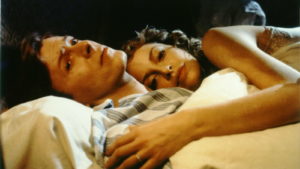STUDIO: Shout! Factory | DIRECTOR: David Hemmings | CAST: David Bowie, Sydne Rome, Kim Novak, David Hemmings, Maria Schell, Curd Jürgens, Erika Pluhar, Marlene Dietrich
RELEASE DATE: 6/29/21 | PRICE: DVD $11.99, Blu-ray $17.99
BONUSES: featurette with producer/writer Joshua Sinclair and assistant director Rory Maclean; audio commentary by Rory Maclean
SPECS: NR | 105 min. | Comedy drama | 1:85 | DTS-HD Master Audio
David Bowie referred to this seriocomic film set in Weimar-era Germany as “my 32 Elvis Presley movies rolled into one.” In this case, the Thin White Duke was exaggerating quite a bit, since Just a Gigolo (1978) — while not a classic by any means — has its share of truly memorable sequences and a sublime cast whose presence compensates for the odd jumps from satire to drama and back.
The plot follows Paul von Przygodski, a Prussian WWI vet (Bowie) recovering from a bomb attack only to find that his family’s wealth is gone. He proceeds through a few menial jobs, finally discovering steady work as a gigolo, working under a renowned madam (Marlene Dietrich, The Scarlet Empress), headquartered in a ritzy hotel. Along the way he is aided by a fellow veteran turned Nazi party organizer (David Hemmings, who also directed) and has flings with a revolutionary (Sydne Rome, What?) and a society widow (Kim Novak, Pal Joey), both seeking a sophisticated escort and lover.
The film is indeed on firmer ground when it is a comedy — the score screams “Euro farce” with its ragtime piano sound. Intended as a satire, its more serious points are made in dramatic scenes that occasionally work because of the strength of the casting. But Gigolo would’ve received kinder reviews upon its release if it had simply gone comic and stayed comic for the duration.
As it stands, certain scenes are very good, including the initial ways that Bowie’s trademark elegance is undermined by odd elements — including an initial pet pig everyone wants to eat and a ridiculous job as a walking beer ad (ensconced inside a giant bottle). In other sequences, the actors “sell” the humorous side of the tale, as when Hemmings tries to recruit Bowie into the Nazi party from his headquarters, an abandoned subway train he lives in that is located in a tunnel. Another memorable moment finds Bowie “paid for” by Novak, who then requests he impregnate her while her wizened old husband is allowed to watch.
The script is indeed uneven and the jumps in tone are jarring. However, the cast — a group of top-notch pros from the past — keep the picture moving along even when it has slid into its less successful dramatic mode. Among the seasoned cast members are a number of supporting performers from Germany’s cinematic past, including Curd Jürgens and Maria Schell.
Hemming is excellent in his farcical (but still menacing) role as the head of the local Nazi sect. His performance is more even in tone than his direction, but it provides a clue as to how the film could’ve conveyed its satirical message if it hadn’t included dramatic moments.
The biggest coup for the producers (in terms of Weimar “cred”) was getting Dietrich to play the madam. Heavily made-up and wearing a veil, she made her last screen appearance here — her preceding performance was in Judgment in Nuremberg in 1961. She is onscreen briefly (around seven minutes) but does exude glamour and connects the film to its time period. Her performance is little more than an extended cameo, but the invaluable grace note is that she also is seen singing “Just a Gigolo” (originally a German ballad). Making this not only her last film as an actress but also the last time she sang publicly. (She stopped giving concerts in the mid-Seventies.)
Contributing a key supporting performance is another Hollywood icon, Kim Novak. She is only onscreen for 15 minutes, but she is terrific, giving a light comic performance here that reminds one of her work for Richard Quine (Bell, Book and Candle, The Notorious Landlady). Her turn makes one wish she hadn’t had such a sporadic presence in movies after the mid-Sixties.
And then there is Bowie himself. He had only acted in one feature film prior to this (The Man Who Fell to Earth), but he shows here that he was a perfectly capable light comedian. One interesting fact about his acting work is that this is one of the few times that he had both starring status and is in the bulk of a film. He was a glorified supporting performer in later films like Merry Christmas, Mr. Lawrence and Labyrinth. Gigolo rates with Man Who Fell… and the very light Linguini Incident (which is a lot closer to being “32 Elvis Presley films” than Gigolo) as one of the only times he had a significant amount of screen time in a film in which he “starred.” The only other exception is his second Weimar-related film, the 1982 BBC adaptation of Brecht’s Baal by Alan Clarke.
This release of Gigolo is the first U.S. appearance of the film since the Water Bearer Films VHS, which was a cropped presentation of the American theatrical version of the film, missing seven minutes. The sole new, onscreen supplement created for this package offers much information about the genesis of the project, the shoot and is reception by the press. Producer-coscripter Joshua Sinclair discusses how producer Rolf Thiele intended it to be the “Strangelove of National Socialism” and how Sinclair was called upon to assemble all the elements.
In the process we learn how much the two female icons charged the production — Kim Novak earned $100,000 for a few days work, while Dietrich’s salary was 250K for two days work. Sinclair recounts how he wooed Dietrich with regular deliveries of roses and champagne. Once he had her interest, he then had to quickly write a role for her. (There was none in the original script.) He claims he wrote her dialogue on toilet paper inserted into the script. The typing job on the notes he expected never happened, and so he maintains Dietrich agreed to appear in the film based on a script with toilet paper inserts.
He also notes that it cost an additional half a million dollars to shoot her scenes in Paris, since she refused to return to West Berlin, where she had been booed and heckled during her one post-WWII concert tour of Germany. This meant the meeting of two entertainment legends, Dietrich and Bowie, that occurs in the film never actually happened in real life. (Bowie’s scenes were shot in Berlin and the Paris footage was edited in, with Hemmings standing in for Bowie in Dietrich’s big scene.)
Assistant director Rory MacLean also supplies personal reminiscences on unknown aspects of the shoot. Among these, he talks about Bowie quickly composing and recording a song for the film — the instrumental “Revolutionary Song” with Bowie humming is heard briefly early on.
The most unique information MacLean imparts is about the Paris shoot with Dietrich, which was the first time she had worked with a German film crew since before the War. MacLean recounts the event in great detail, including a speech Marlene made to the crew when the shoot was over, in which she described her sadness at “losing” her country and her language.
Given MacLean’s enthusiasm for chronicling all aspects of the shoot, it’s rather interesting to hear him discuss why the film ultimately flopped at the box office and with critics. According to its assistant director, it’s a “failed attempt to use humor as a means of understanding the past” and “a comedy that couldn’t decide what kind of comedy it was.”
MacLean takes this even further in the audio commentary, where he somewhat melodramatically elaborates the virtues of the film — singing the praises of Hemmings, Bowie, and Dietrich — yet also decimates its miscalculations. This starts with him decrying “the disastrous, circus-like, jolly 1920s ragtime score,” which he found “totally inappropriate, destroying the on-screen atmosphere.” He tears into Sydne Rome, quoting a bad review she received from The New York Times and stating “why she was part of the picture remains a mystery to me.”
Other stories MacLean tells are jaw-droppers that have only tangential connections to Gigolo: at one such moment he speaks of Bowie and Iggy Pop doing drugs in Berlin (a few years before the film was shot) “while watching Starsky and Hutch and Triumph of the Will.” He also recounts being brought to a noted Berlin gay bar (depicted in the film) where the former Ziggy Stardust had a drag performer at the club sit in the uptight young MacLean’s lap.
As for Hemmings, he depicts him as a talented, charming and perpetually boozed-up individual who had no problem trading on his major successes from the 1960s. At one point, he outlines how Hemmings engaged on the set in some very un-gentlemanly talk about an affair he had with Novak in the mid-Sixties. In “a particularly graphic manner,” the Blow-Up star praised her as “the finest director of the Hoover corporation.” MacLean adds, “I won’t elaborate,” but one is surprised he says as much as he does.
At one point, MacLean runs through his own CV (of both jobs and treasured moments with celebs) to establish his bona fides in the film world. Toward the end of his commentary, though, he ventures into an area few DVD contributors go (outside of those doing supplements for Ed Wood movies), recounting the public and critical reception for Gigolo: “The film died. It was a bad job, a let-down, a turkey, it won no Oscar, received no BAFTA nominations. In fact the only honor it ever secured was to be named the worst film ever made.” (But has he seen The Linguini Incident?)
MacLean ends his commentary with the same remarks he makes in the video and then provides a “what happened to…?” for the major participants in Gigolo, noting that actor-director Hemmings died on a movie set after lamenting that “People thought I was dead. But I wasn’t — I was just directing The A-Team….”
|
Buy or Rent Just a Gigolo
|
|---|


Leave a Reply